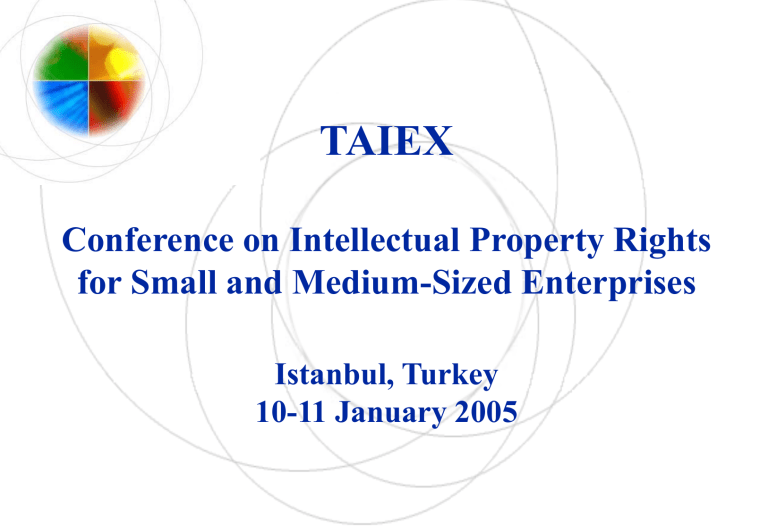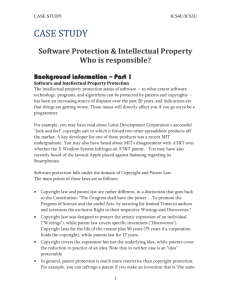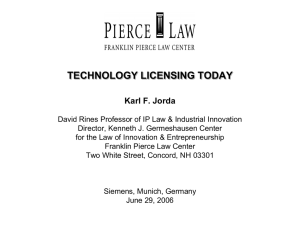Template wipo

TAIEX
Conference on Intellectual Property Rights for Small and Medium-Sized Enterprises
Istanbul, Turkey
10-11 January 2005
Integrating IP in the Business Plan and Strategy
Cherine Rahmy
Counsellor
SMEs Division, WIPO
Key Questions
– What IP assets does the business own
– What is the status of the company’s IP
Portfolio
– How important are IP assets to the business
– How does the company protect its IP assets
– What is the company’s IP policy and strategy
What IP assets do you own?
• Identify and classify your IP portfolio. This includes confidential information/trade secrets, trade names, trademarks, domain names, industrial designs, copyright and related rights and patents and utility models
• What other intangible assets do you have
(such as license, franchise, distribution agreements etc.)
What is the status of your IP portfolio
– Do you know all your IP Assets
– Do you have an IP portfolio and is it up to date
– Which of your IP assets are registrable? and should they be registered?
– Are they registered in potential foreign markets
– Do you conduct IP Audits?
What is the status of your IP portfolio
To be able to make effective use of IP, an enterprise must undertake an IP Audit i.e identify
• the type of IP rights it owns
• other people/enterprises IP that it uses or intends to use
How important are IP assets to the success of your business
• What is the current value and /or future potential of your IP assets
• How essential are IP assets for the commercial success of your business
• What competitive advantage do your IP assets provide
How do you plan to protect your IP assets
• If you commercialize your IP assets, do you plan to secure ownership
• if you outsource part of your business, do you have contracts protecting your IP rights
• how secret is your business information strategy
Do you have an IP policy and strategy
• How do you identify, protect and manage your
IP assets
• How do you exploit your IP assets : have you considered using IP assets as security of collateral
• In house IP focal point/department
IP Focal point
• Driving Force to:
– Spur creativity, inventions and innovations
• State of the Art/Patent Search
• Rules on employees inventions/reward system
• In-house IP culture
– identify, protect and maintain IP rights
– Monitor and exploit IP rights
– IP Audit
CORPORATE IP
MANAGEMENT
IP AND BUSINESS
STRATEGY
• Corporate IP management means: development of an IP strategy on acquisition, exploitation, monitoring and enforcement of IP rights inclusion of IP in the overall business strategy of the enterprise
IP STRATEGY
1. Strategy on IP acquisition
2. Strategy on IP exploitation
3. Strategy on IP Monitoring
4. Strategy on IP enforcement
Strategy on IP
Acquisition
• Incentives for employees for the development of IP assets
• For registrable industrial property rights:
– To apply or not to apply: costs-benefit analysis, patents vs. trade secrets, registered or unregistered works and designs
– When to apply: Timing of application for registration
– What to apply for: some features of a product may be protected with one or more IP rights. E.g. shape of bottle, textile design, software, etc.
– Where to apply (national, regional or international protection)
– Legal and technical advice
– In-house IP department or external IP lawyer/patent agent
Strategy on IP
Acquisition (2)
– Offensive patenting vs. defensive patenting
– One product, many IP rights: protecting a single product with a whole variety of rights
– Patent mining
• For copyright
– Is there a copyright depositary? If so, when, where and how should the work be deposited?
• For trade secrets
– Confidentiality agreement with employees?
– Non-disclosure agreements with partners?
– If the information is patentable, should it be patented?
Strategies for the Exploitation of Certain IP Rights
• Patents, utility models and industrial designs:
– Commercialization of invention vs. Licensing vs. Sale of patent vs.
Joint venture
• Copyright and related rights:
– Should the creator join a collective management society? Licensing policy on package? Agreements between authors/creators and publishers, editors, broadcasters, performers, etc.?
• Trademarks:
– Effective use in marketing strategy to differentiate products, increase brand loyalty, enhance reputation, target specific markets
– Franchising
Some General Strategies on IP Exploitation
– IP audit: taking stock of all IP (how is it currently exploited?)
– Policy for subcontracting and commissioning of work: who owns the rights?
– Using IP to raise funds (including all IP assets in business plans for investors)
– IP valuation: important for licensing, during M&As, to report to shareholders and investors
– Cross-licensing: using IP as a negotiating tool to obtain licenses from other companies
– Strategic Alliances: ( with other companies, with universities and research centers, etc)
Strategy on IP Monitoring
• Patent monitoring:
– To obtain technical, commercial and legal information
– Patent mapping: mapping the landscape of patents owned by own company and others
• Trademark monitoring:
– Before registering a trademark
– To invalidate identical or confusingly similar marks during opposition period
Strategy on IP Enforcement
• IP insurance: cost-benefit analysis
• Arbitration and/or mediation clauses in licensing contracts (e.g.
WIPO model clauses)
• “Cease or desist” letters
• When and how to contact enforcement authorities
BUSINESS STRATEGY
• Integrating IP in overall business strategy means including IP considerations in the following:
– R&D strategy
– Funding strategy
– Marketing strategy
– Accounting
– Technology acquisition
– Export/foreign investment strategy
IP and R&D Strategy
• Use of patent information
• Target R&D activities towards patentable inventions
• Liaise with (in-house and external) lawyers and/or patent agents during R&D
• Consider best means of protecting R&D results
IP and Funding Strategy
• Inclusion of IP within business plans presented to investors (particularly venture capitalists)
• IP securitization
• IP as collateral
• Licensing IP: may provide a constant revenue stream from royalties (e.g. Hitachi or IBM)
• Example:
– IP rights are one of the 5 main criteria used by European venture capitalists in their decisions to fund SMEs
IP and Marketing
Strategy
• Trademarks and industrial designs integral to the marketing strategy
– Creation/Selection of mark important for brand image
– Registration of marks important for safeguarding investments in marketing
– Marks and designs: useful for segmenting markets and targeting specific groups of customers (e.g. children, young women)
– Marks and industrial designs may reinforce each other
IP and Marketing
Strategy (2)
– Creative design as a basis for an advertising strategy
– Brand extension vs. sub-brands vs. new brands for new products
– Use of collective and certification marks as a quality guarantee for marketing a product
IP and Accounting
• Valuation of IP assets important for mergers and acquisitions, calculation of licensing royalties, etc.
• Inclusion of IP assets in balance sheet? (How should it be measured)?
• IP may enhance the market value of the firm in the eyes of investors, shareholders, etc.
IP and Technology
Acquisition
• Use of patent information to find suppliers of patented technologies
• Acquisition of new technologies via licensing of patented technology, know-how, trade secrets,etc
• Registration of technology transfer agreements (if appropriate) to obtain tax benefits
Export / Foreign
Investment Strategy
• Decision on whether to export a product, license to foreign manufacturers/distributors, franchise or invest in a local company will be affected by IP considerations
• Timing of applications for IP rights abroad is crucial
• Negotiations on ownership of IP rights abroad with foreign partners
Final Remark
• An SME’s corporate IP strategy will depend considerably on its innovative capacity, financial resources, field of technology, competitive environment, etc.
BUT: Ignoring the IP system altogether, as is often the case for SMEs, is in itself an IP strategy and may eventually prove costly.






